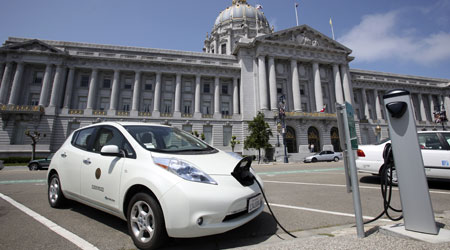
President Biden's E.O. to Move All Federal Vehicles to Electric
February 2, 2021
During the press conference about his executive order to expand the “Buy American” Act, President Biden talked about moving the federal fleet to all electric vehicles (EVs) as part of the initiative. A timeline and specifics about making the fleet EV is not included in the wording of E.O. 14005. However, the statements do seem to indicate an intent that will have an implication for government facilities — where are those vehicles going to charge up?
The current federal fleet does have some electric vehicles in its mix. The federal fleet of about 645,000 vehicles is mostly larger vehicles, with 65 percent being light to heavy duty trucks. Passenger vehicles, like SUVS and sedans, make up another 34 percent. Through 2019, the total federal fleet of EVs numbered 2,054 vehicles, with purchases starting in 2010 adding a couple hundred units per year, according to a report by the U.S. General Services Administration.
Many government facilities already have some electric vehicle charging capacity in place, in part due to the 2015 Fixing America’s Surface Transportation Act (FAST Act). A November 2020 document, Federal Workplace Charging Program Guide, from the U.S. Department of Energy (DOE) Office of Energy Efficiency and Renewable Energy, details some of the considerations facility managers in federal facilities must take into account when evaluating EV charging needs at their location. For example, due to the FAST Act, the cost of installing and using EV charging stations installed after 2015 at federal properties has to be passed back to the user, and primarily concerns employees charging up their private EVs at work.
Facility managers will need to evaluate if and how to increase their charging capacity given the Biden administration’s intent. EVs come with chargers that can plug into 120-volt receptacles, so simply installing a bank of these receptacles can be an inexpensive way to meet basic charging needs. One cost to watch is trenching, which can be as high as $150 per foot, according to the DOE. Placing charging spots as close as possible to the electric service panel will help to keep these costs down.
A 120-volt receptacle is a very slow way to charge a vehicle, meaning that a parking slot will be occupied for many hours to provide a meaningful charge. It also makes it harder to capture the data required to be reported by the FAST Act. GSA has a blanket purchase agreement for Level 1, 2, and DC fast chargers from 5 manufacturers as one option for sourcing faster charging options which also aid in reporting. Many utilities and municipalities have programs and incentives for installing vehicle charging stations as well. One resource to find these options is here.
Part of providing sufficient charging infrastructure involves making sure fleet vehicles have access when needed. If current EV charging infrastructure is shared between the fleet vehicles and private vehicles, this could mean designating charging stations just for fleet vehicles, or designating certain times of day just for fleet charging, such as after 5 pm. If the charging infrastructure at a facility is currently primarily used to charge private vehicles, a communication campaign surrounding changing availability in the future might be needed.
In addition, providing additional EV charging might also require upgrading electrical panels and transformers. It all depends on how many vehicles will need to be charged at the same time and how quickly. DOE offers that the average workplace EV charging station consumes less than 10kWh of electricity per day, for private vehicle charging. However this figure might be impacted by the larger heavier duty EVs coming onto the market, such as trucks and SUVs.
Naomi Millán is editor of Building Operating Management.
Next
Read next on FacilitiesNet












